Import Spotify playlist to YouTube account with NodeJS
 Indrajit Sahani
Indrajit SahaniTable of contents
- Introduction
- Project Setup
- Setting up Spotify
- Getting Spotify token
- Import Spotify playlist to YouTube
- Getting song detail from Spotify playlist
- Creating YouTube Playlist with API
- Searching song on YouTube with API
- Adding songs to the playlist with API
- Adding all the songs from Spotify to YouTube
- Setting up /playlist route in express
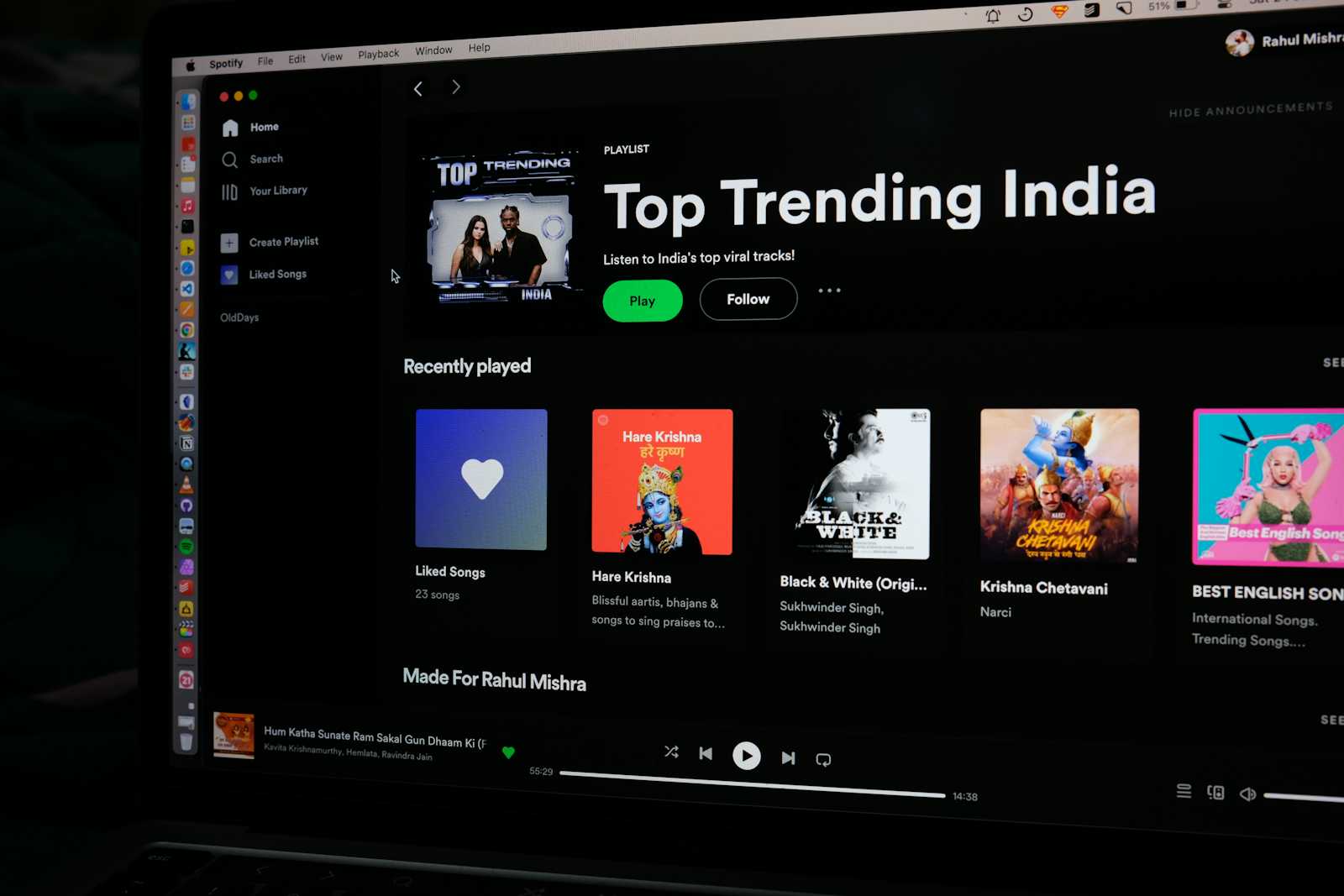
Introduction
I have always used Spotify(free) for listening song but recently they increased there ad on there platform so I decided to switch to YouTube music since i had YouTube premium. But all of my playlist were on Spotify, manually adding all song to YouTube playlist would have been time consuming and boring so i decided to write a script that take Spotify playlist and make a YouTube playlist on my account.
In this article, I'll show you how to create a Nodejs application that can create YouTube playlist of songs with Spotify playlist links. Checkout code on GitHub
Let's START!
Project Setup
1. Create Node.js Project:
To start our project, we need to set up a Node.js environment. So, let's create a node project. Run the following command in the Terminal.
npm init -y
This will initialize a new Node.js project.
2. Install Dependencies:
Now, We'll install the required dependencies of our project.
npm install axios cookie-parser dotenv express googleapis
This will install the following packages:
Axios: A promise-based HTTP client for the browser and Node.js, often used to make HTTP requests and handle responses in a simpler way than the built-in
fetchAPI.Cookie-Parser: A middleware for Express.js that parses cookies attached to the client request object, making it easier to handle cookies in your web applications.
Express: a popular web framework for Node.js
Dotenv: loads environment variables from a
.envfile.Googleapis: Provides access to various Google APIs.3. Setup Environment Variables:
3. Setup Environment Variables:
Next, we'll create a .env folder to securely store our sensitive information such as API credentials.
//.env
PORT=3000
CLIENTID=YOUR_SPOTIFY_CLIENTID
CLIENTSECRET=YOUR_SPOTIFY_CLIENTSECRET
YOUTUBEKEY=YOUR_YOUTUBE_KEY
YOUTUBECLIENTID=YOUR_YOUTUBE_CLIENTID
YOUTUBECLIENTSECRET=YOUR_YOUTUBE_CLIENTSECRET
4. Create Express Server:
Now, we'll create a index.js file in the root directory and set up a basic express server. See the following code:
//index.js
import express from 'express'
import dotenv from 'dotenv'
import cors from 'cors';
import morgan from 'morgan';
import router from './src/routes/route.js';
dotenv.config()
const port = process.env.PORT || 3000
const app = express()
app.use(express.json());
app.use('/user', router)
app.listen(port, () => {
console.log(`Server is running on port ${port}`);
});
Here, We're using the "dotenv" package to access the PORT number from the .env file.
At the top of the project, we're loading environment variables using dotenv.config() to make it accessible throughout the file.
Setting Up Google Console
At First, We'll go to the Google Cloud Console.
Then we'll get this Dashboard. (I have previously created one project that's why I'm getting this, you might get something else)

Now, We'll click on the 'New Project' button to start a new project.
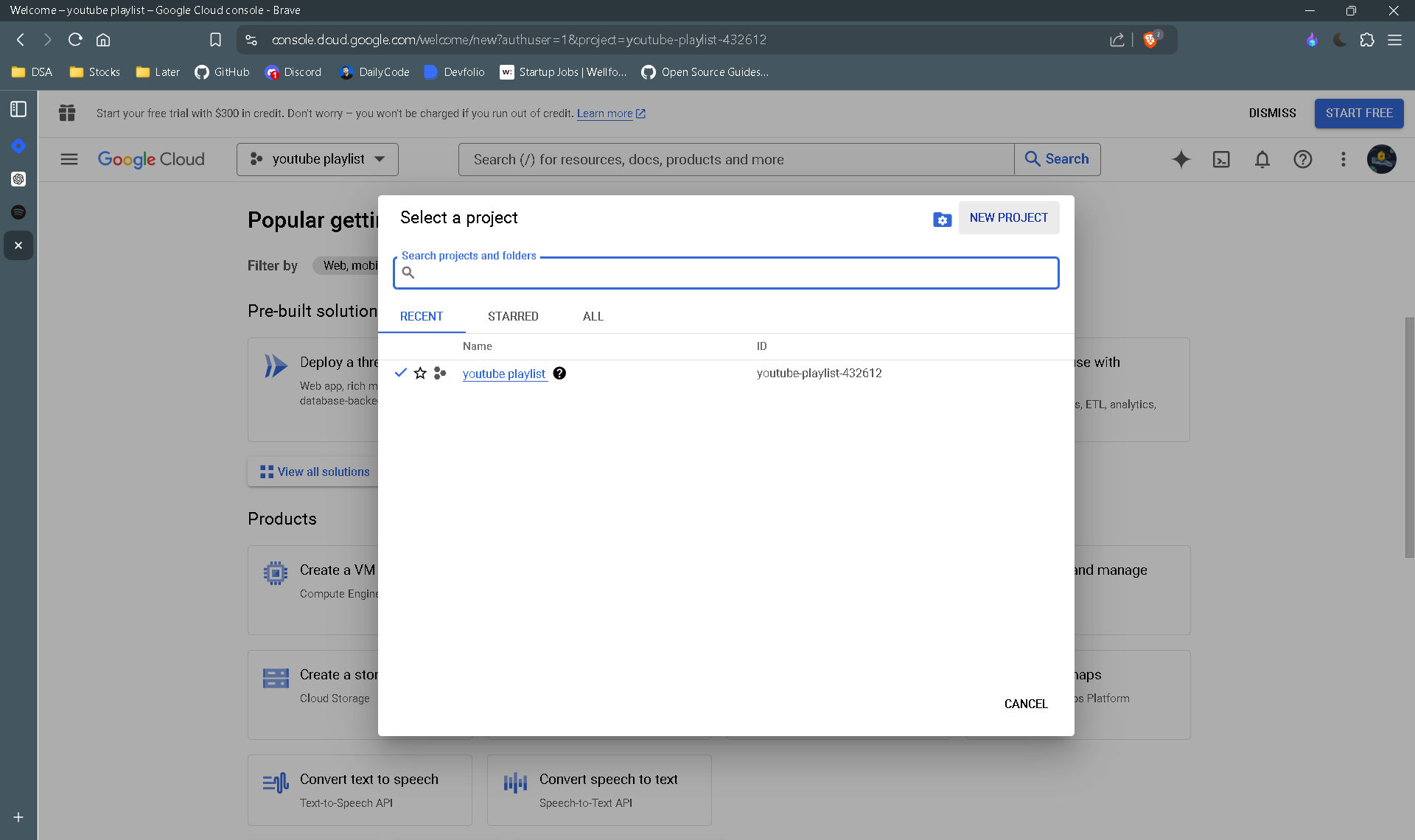
Next up we'll get something like this. Here we'll add our Project's name and organization.
For this project, I'm keeping this as "Youtube Playlist". Then we'll Click the Create button to proceed

Next, In the Side Navigation bar, we'll get "APIs and Services". Within this section, there's a submenu to enable APIs and services. we'll click that to proceed.

Next, We'll enable the API that we'll be using in this project ie. the Google Calender API.
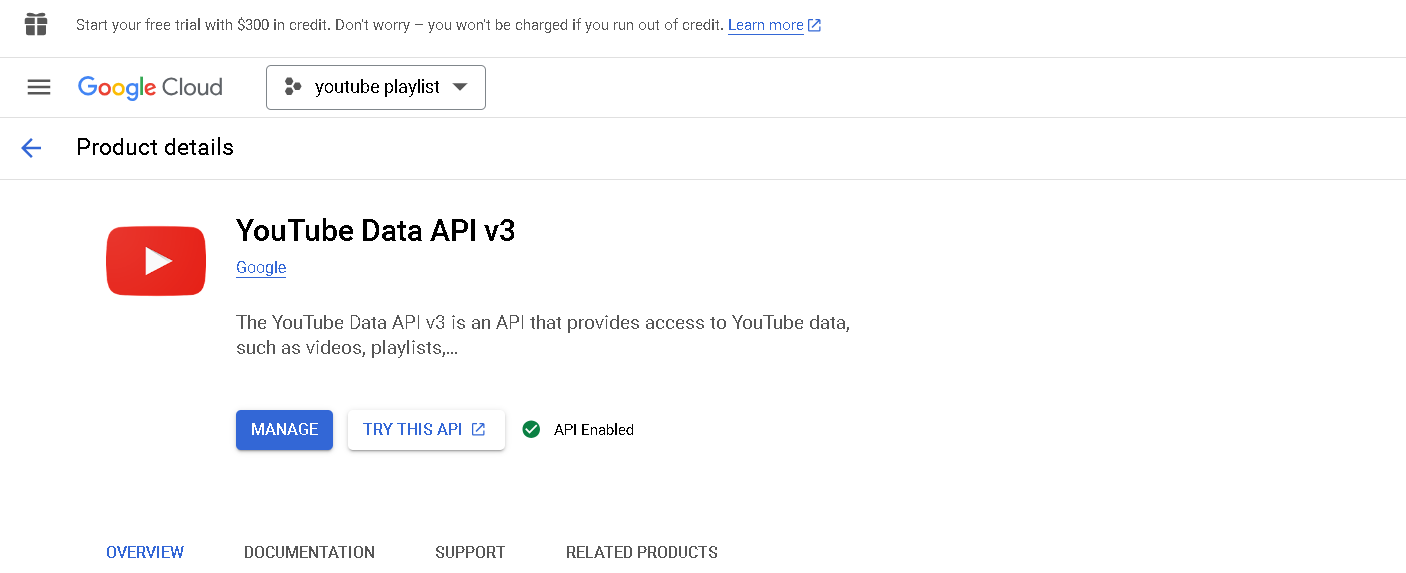
After that, we'll go to the OAuth Consent Screen. Here we'll select the User Type as External. And we'll press Create button to proceed.

Then we'll go to the app registration page.
Here we'll be adding more information about our application. We start by adding the name of our app and an email address for user support.
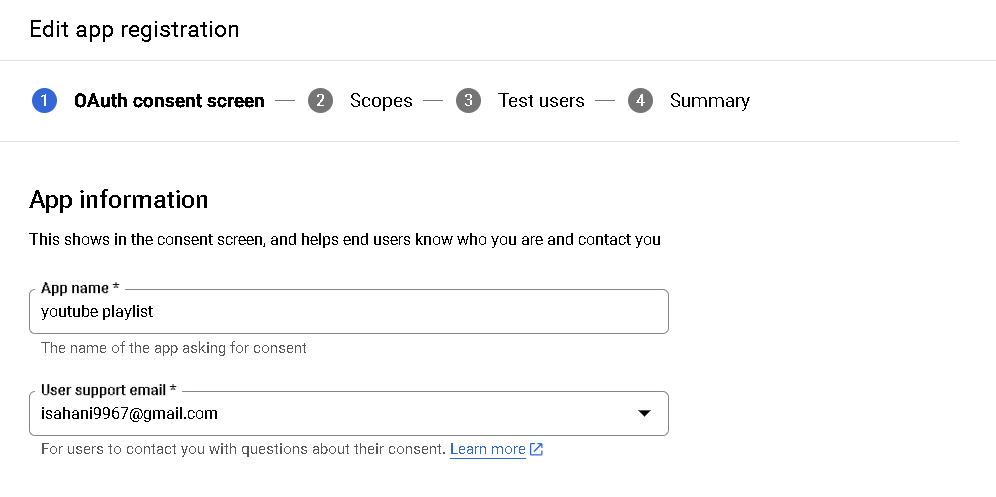
In the Scopes, We'll add necessary permissions such as userinfo.email , userinfo.profile , youtube, youtube.readonly and youtube.force-ssl for this project.
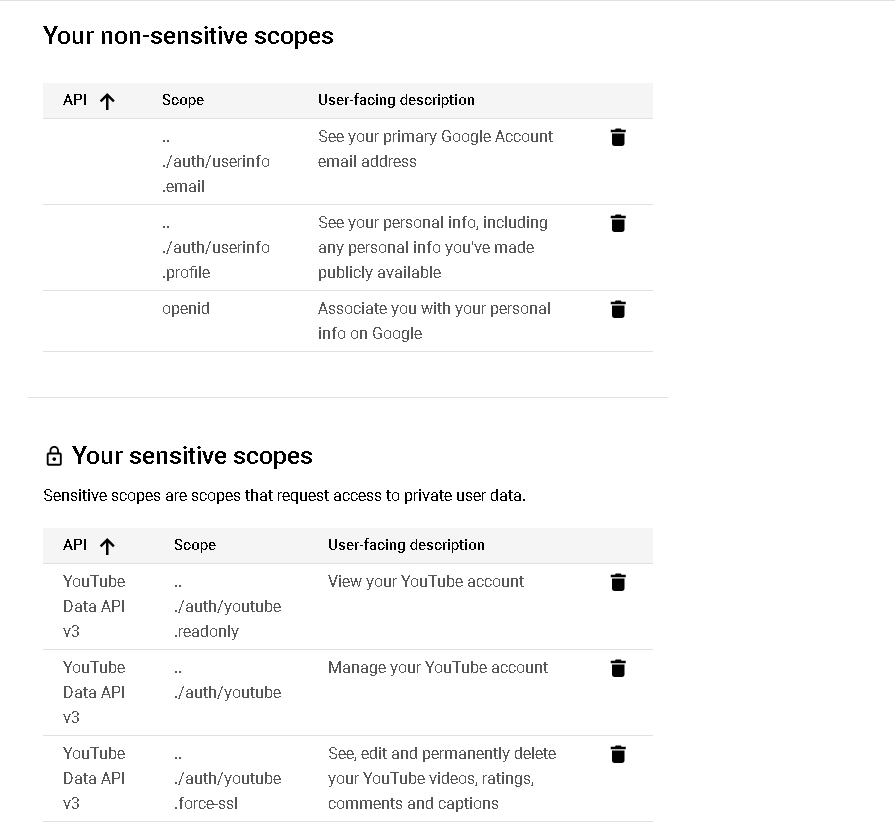
After that, We will add one test user to our Application.
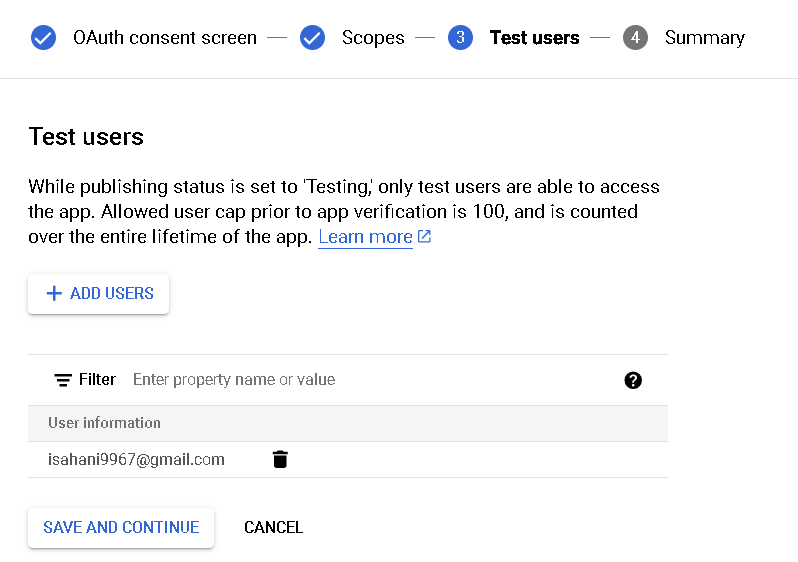
That's it. Our Application is registered with the platform.
Now, We'll create our OAuth Client ID secret. For that, we'll go over to the Create Credential part.

Here we'll add the type of our Apllication and It's name. For this project its web application and the name is Web client 1.
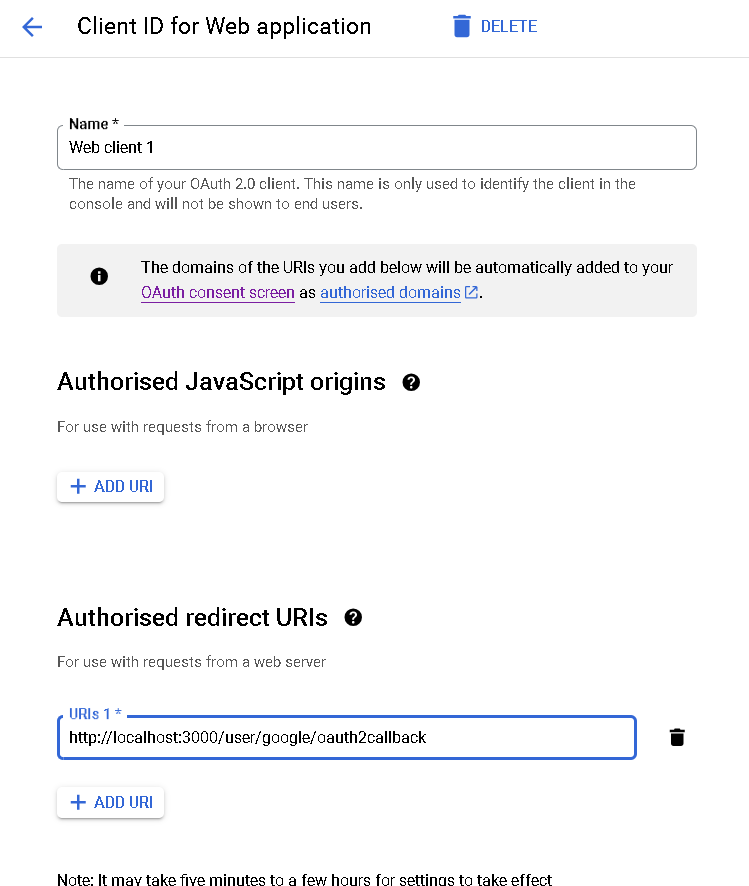
And then we'll get the OAuth credential.

Next up we'll create YouTube API Keys.

After doing all this we'll Update our .env file with the API keys and the OAuth Credentials that we have generated earlier.
With this, we have set up our Google Cloud console for this project, now let's move to the next section
Setting up Spotify
Log into the dashboard using your Spotify account.
Create an app and select "Web API" for the question asking which APIs are you planning to use. Once you have created your app, you will have access to the app credentials. These will be required for API authorization to obtain an access token.
Use the access token in your API requests.
For more information visit Spotify web api docs
After doing all this we'll Update our .env file with CLIENTID and CLIENTSECRET that we have generated earlier.
Now let's move to the next section.
OAuth 2 Authentication:
Till now we have done our basic project setup. Now, we'll integrate OAuth2 Authentication into our Project. This enables our application to interact securely with Google services.
For that, First We'll import the required packages into the getYoutubeToken.js file.
//route.js
import Router from 'express'
import { google } from 'googleapis'
import cookieParser from 'cookie-parser'
import env from 'dotenv'
env.config()
Then we'll define the scope of access required for the Google Calendar API.
//route.js
const SCOPES = ['https://www.googleapis.com/auth/youtube',
'https://www.googleapis.com/auth/youtube.force-ssl'];
Next, We'll configure the OAuth 2 client using the credentials that we have stored in the .env file.
//getYoutubeToken.js
// OAuth 2 configuration
const oauth2Client = new google.auth.OAuth2
(
process.env.CLIENT_ID,
process.env.CLIENT_SECRET,
process.env.REDIRECT_URL
);
After the OAuth 2 Configuration, We'll create a Route to Authenticate our Users.
//getYoutubeToken.js
// Step 1: Redirect to Google's OAuth 2.0 server
route.get('/auth', (req, res) => {
const authUrl = oauth2Client.generateAuthUrl({
access_type: 'offline',
scope: SCOPES,
});
res.redirect(authUrl);
});
When our users go to this route, they'll be redirected to Google's authentication page where it will ask for specific permissions to our application.
After Successful authentication, Google will redirect the user to our Redirect URL (/user/google/oauth2callback)
//getYoutubeToken.js
// Step 2: Exchange authorization code for access token
route.get('/oauth2callback', async (req, res) => {
const code = req.query.code;
try {
const { tokens } = await oauth2Client.getToken(code);
oauth2Client.setCredentials(tokens);
res.send('Authentication successful! Please return to the console.');
// Store the access token in a cookie
res.cookie('youtube_access_token', tokens.access_token);
} catch (error) {
console.error('Error retrieving access token', error);
res.send('Error retrieving access token');
}
});
Here we are getting the refresh tokens from the Query and storing them as credentials in the oauth2Client. These credentials will help us to make request to the Google YouTube API.
Getting Spotify token
Next well will call Spotify API to get access token so we can call Spotify music API.
For getting access token we will have to send client_id and client_secret to https://accounts.spotify.com/api/token
//getSpotifyToken.js
import axios from "axios";
async function getSpotifyToken() {
try {
const client_id = process.env.CLIENTID
const client_secret = process.env.CLIENTSECRET
const authHeader = Buffer.from(`${client_id}:${client_secret}`).toString('base64');
const response = await axios.post("https://accounts.spotify.com/api/token",
new URLSearchParams({
grant_type: 'client_credentials'
}).toString()
,
{
headers: {
'Authorization': `Basic ${authHeader}`,
'Content-Type': 'application/x-www-form-urlencoded'
}
}
)
return response.data.access_token;
}
catch (error) {
console.error('Error fetching Spotify token:', error.response ? error.response.data : error.message);
}
}
Now that we have both Spotify and YouTube access token we can go ahead and call YouTube and Spotify API. But before that let understand how are we going to Import Spotify playlist to YouTube account.
Import Spotify playlist to YouTube
Firstly we will call Spotify playlist API to get the song name and Artist name of all song in the playlist and store that in an array.
Then we will create an empty playlist using YouTube API.
After that we will search the song on YouTube by giving song name and Artist name stored in an array.
After finding the song we will add the song to the playlist.
Getting song detail from Spotify playlist
In this function we are calling Spotify API with playlist Id https://api.spotify.com/v1/playlists/${playlistId}/tracks
//getSongDetail.js
import axios from "axios"
async function getSongDetail(data, response) {
try {
const playlistId = data.split('/playlist/')[1];
const songsData = await axios.get(`https://api.spotify.com/v1/playlists/${playlistId}/tracks`, {
headers: {
'Authorization': `Bearer ${response}`
}
})
const songDetail = songsData.data.items.map((i) => {
const songName = i.track.name;
const songArtist = i.track.artists[0].name;
return ({ song: songName, artists: songArtist })
})
return songDetail
}
catch (error) {
console.error('Error fetching playlist tracks:', error.response ? error.response.data : error.message);
}
}
export default getSongDetail
After calling this function we will get an array with song name and Artist name of all the song in the playlist.
Now that we have songs detail lets how we are going to create a YouTube playlist.
Creating YouTube Playlist with API
In this function we are calling YouTube API with playlist title and description in request Body.
//createPlaylist.js
import { google } from "googleapis";
async function createPlaylist(auth) {
const youtube = google.youtube({ version: 'v3', auth });
const response = await youtube.playlists.insert({
part: 'snippet,status',
requestBody: {
snippet: {
title: "songs",
description: "spotify playlist songs in one place",
},
status: {
privacyStatus: 'public',
},
},
});
return response.data.id;
}
export default createPlaylist
After calling this function we will get the playlist id of playlist we just created. We are going to use this playlist id to add songs to it after finding the song.
Now that we have playlist id lets how we are going to find the songs.
Searching song on YouTube with API
we are going to search song through YouTube API by passing part:'snippet', q:query(song and Artist name), type: 'video', maxResults: 1
//searchVideo.js
import { google } from "googleapis";
async function searchVideo(auth, query) {
const youtube = google.youtube({ version: 'v3', auth });
const response = await youtube.search.list({
part: 'snippet',
q: query,
type: 'video',
maxResults: 1, // You can adjust this as needed
});
if (response.data.items.length > 0) {
return response.data.items[0].id.videoId; // Returns the video ID
} else {
throw new Error('No video found');
}
}
export default searchVideo
After calling this function we will get the video id of song. We are going to use this video id to add songs to YouTube playlist.
Now that we have playlist id lets how we are going to add the song to the playlist.
Adding songs to the playlist with API
In this function we are going to pass the playlist Id of the playlist we created and the video Id of the song we found.
//addVideotoPlaylist.js
import { google } from "googleapis";
async function addVideoToPlaylist(auth, playlistId, videoId) {
const youtube = google.youtube({ version: 'v3', auth });
const response = await youtube.playlistItems.insert({
part: 'snippet',
requestBody: {
snippet: {
playlistId: playlistId,
resourceId: {
kind: 'youtube#video',
videoId: videoId,
},
},
},
});
return response.data;
}
export default addVideoToPlaylist
Now that we have implemented all the function lets see we are going to add all the from Spotify to YouTube.
Adding all the songs from Spotify to YouTube
- We are going to implement a function that Would search and add video simultaneously.
//searchVideoAndAddVideo.js
import searchVideo from './searchVideo.js'
import addVideoToPlaylist from './addVideotoPlaylist.js'
async function searchVideoAndAddVideo(auth, searchQuery, playlistId) {
try {
const videoId = await searchVideo(auth, searchQuery);
await addVideoToPlaylist(auth, playlistId, videoId);
}
catch (error) {
console.error('Error:', error.message);
}
}
export default searchVideoAndAddVideo
Now we will implement a function that will iterate over the array of song and Artist name and would call searchVideoAndAddVideo function every iteration with song name Artist name and playlist id.
//getYoutubePlaylist.js
import createPlaylist from "./createplaylist.js";
import searchVideoAndAddVideo from "./searchVideoandAddVideo.js";
async function getYoutubePlaylist(detail, auth) {
try {
if (!detail || detail.length === 0) {
console.log('No songs to process.');
return false;
}
let playlistId = await createPlaylist(auth);
for (const i of detail) {
const query = `${i.song} ${i.artists} song`;
try {
await searchVideoAndAddVideo(auth, query, playlistId);
}
catch (error) {
console.error('Error during API call:', error);
}
}
return playlistId; // Return playlist ID on success
}
catch (error) {
console.error('Error creating playlist:', error.message);
return false;
}
}
export default getYoutubePlaylist
After all of it we would create a route /playlist Where we will pass Spotify playlist URL to get the YouTube playlist with all the song in your YouTube account and the URL of YouTube playlist.
Setting up /playlist route in express
route.post('/playlist', async (req, res) => {
//for generating youtube access token
const accessToken = req.cookies.youtube_access_token
if (!accessToken) {
return res.status(401).send('No access token found.');
}
oauth2Client.setCredentials({
access_token: accessToken,
});
//for getting playlist url
const data = req.body.data
if (!data || !data.includes('playlist')) {
return res.json({
msg: "invalid link!! Please only give the link of a playlist"
})
}
//for generating spotify api token
const response = await getToken()
if (!response) {
return res.json({
msg: "Failed to obtain spotify token"
})
}
//for getting all the songs from spotify playlist
const detail = await getDetail(data, response)
//for creating and adding song to user's youtube playlist
const success = await getYoutubePlaylist(detail, oauth2Client)
if (success == false) {
return res.json({
msg: "Developer api Queries quota all used. Try again next day"
})
}
return res.json({
msg: "playlist added",
link: `https://www.youtube.com/playlist?list=${success}`
})
})
In /playlist route we will have to pass Spotify playlist URL in the request body and if the request would be success full we will get the URL of YouTube playlist.
Testing the Application:
The Coding part of our Project is Completed. Now, let's see if it's working or not!
For that, we'll start the project!
npm run dev
And We have started our Server on port 3000!
Now, we'll Go to the http://localhost:3000/user/google/auth Route to Authenticate the user. It will redirect us to something like this:
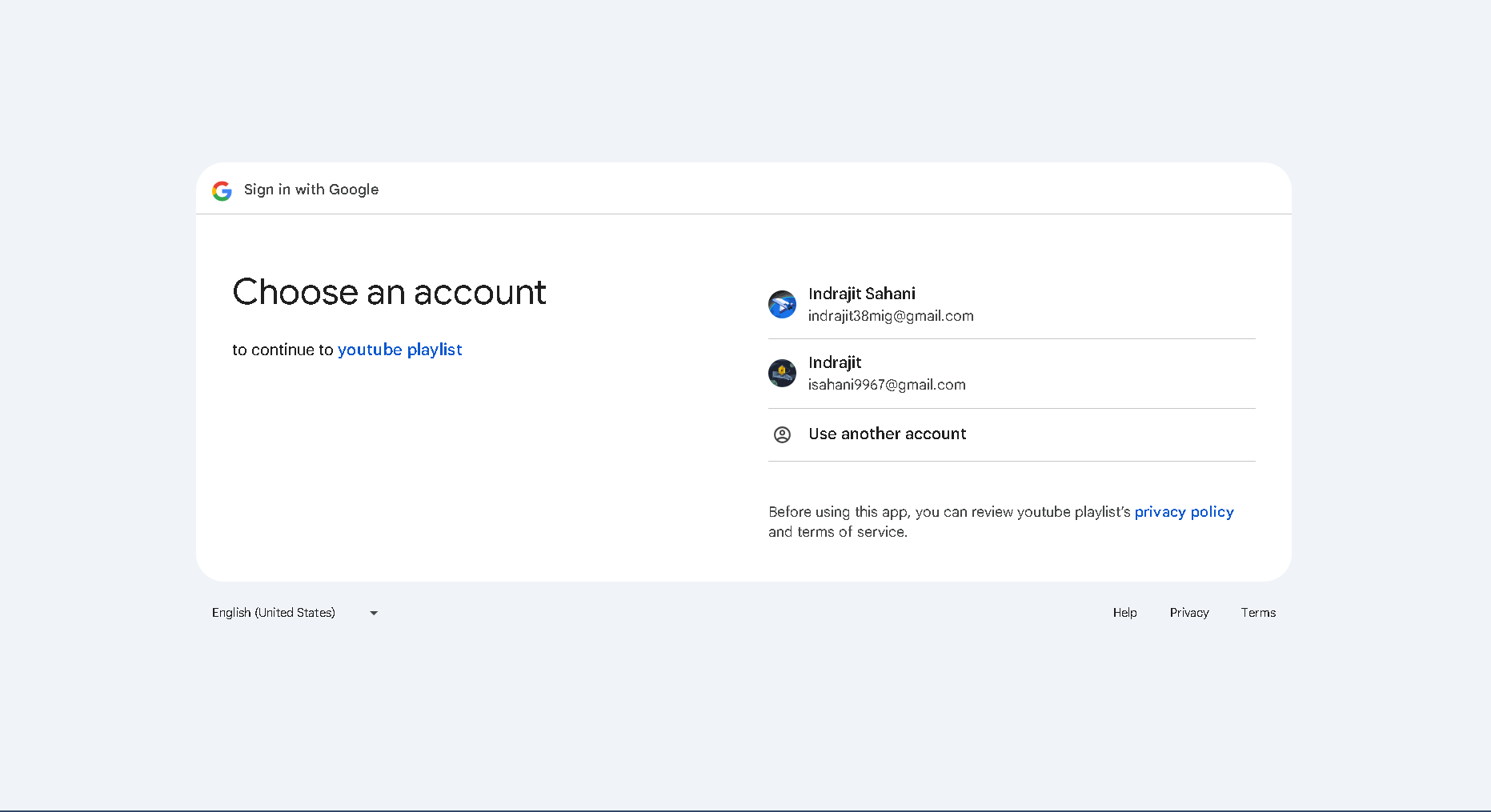
It will ask for some permission for the application
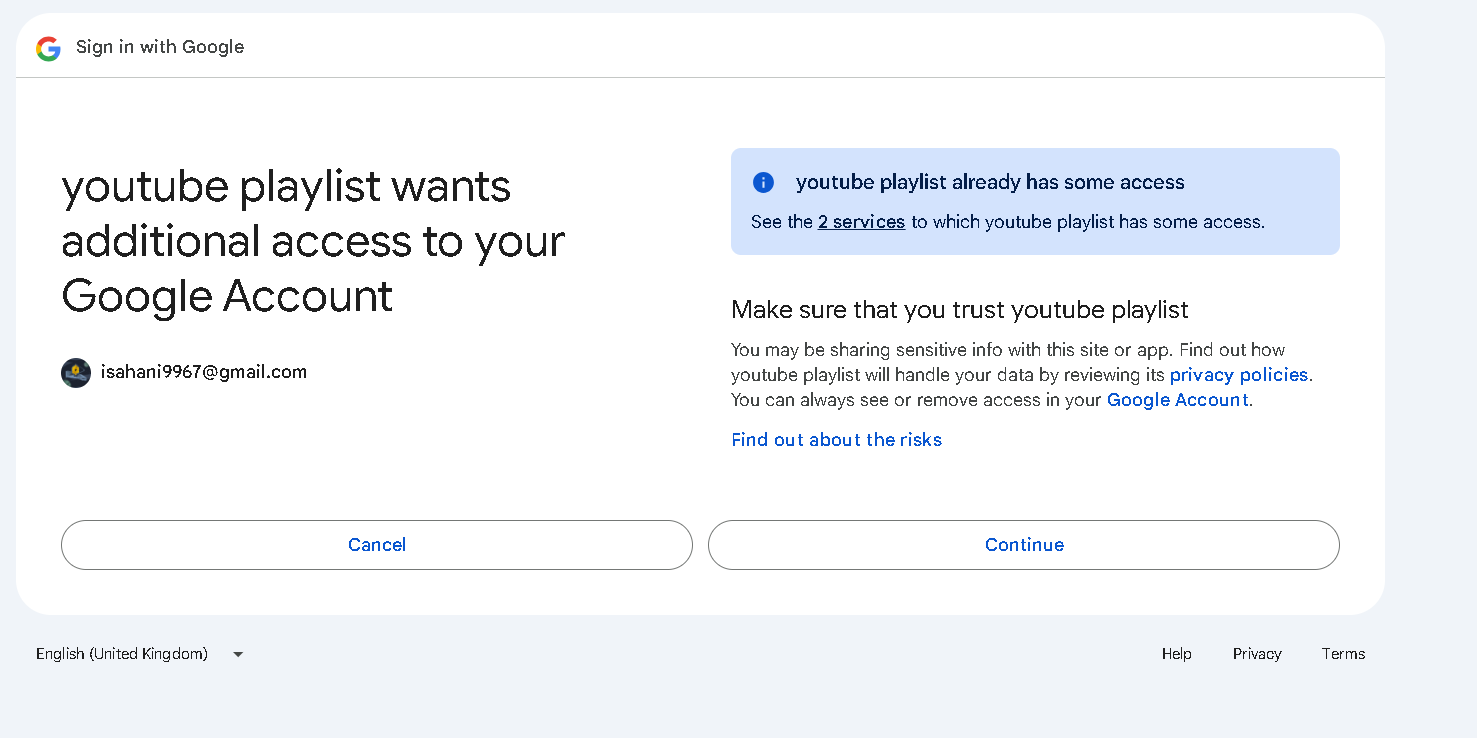
It will redirect to /user/google/oauth2callback route with the code query parameter.
After successfully authenticating the user, We'll go to the http://localhost:3000/user/playlist route to get the link of YouTube playlist with all the song.
To get the link of YouTube playlist go to postman:-
Go to postman set the method to post enter the URL
http://localhost:3000/user/playlistSet the headers to Key- cookie, value-Youtube_access_token=Your_access_token
You would have your Youtube_access_token in the cookie section of
http://localhost:3000/user/google/oauth2callback
Add Spotify link in the body section

Then send the request if the request was successfull You would get the YouTube playlist link

Great! Our Application is working perfectly!
With that, We have integrated YouTube and Spotify API into our Node.js app.
Conclusion
If you found this blog post helpful, please consider sharing it with others who might benefit. You can also follow me for more content on JavaScript, React, and other web Development topics.
Thank you for Reading :)
Subscribe to my newsletter
Read articles from Indrajit Sahani directly inside your inbox. Subscribe to the newsletter, and don't miss out.
Written by

Indrajit Sahani
Indrajit Sahani
Hey, I’m Indrajit Sahani, a computer science student with a passion for web development. As I navigate through my learning journey, I’m committed to sharing my knowledge and insights with the tech community.